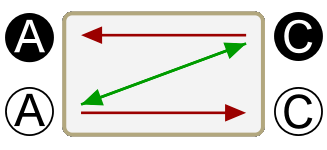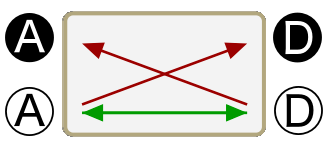
By default, terms A and B and their complements define the initial rectangle to receive the first premise schematic in ReasonLines. Touching one of these letters will bring up a keyboard if some other term is desired. The terms in the conclusion box will initially be the same as those for this first premise. When the first schematic is entered, C and its complement are dimly added to provide a second rectangle for the second schematic, and A and C and their complements will define the conclusion rectangle when a second schematic is added.
If the argument being schematized is the now familiar syllogism,
| All A are B | |
| All B are C | |
| ∴ | All A are C |
then the up-green-z card will be dropped in the first place and C and C will appear , as follows:

Of course, if the premise had been "No A are nonB," "No nonB are A," or "All nonB are nonA" the same schematic would be used since the up-green-z represents all of these sentences. (Clicking or tapping a schematic displays the sentence forms it represents.)
Next the schematic for "All B are C" is the same up-green-z, so it is dropped in its place, as follows:

Now we see that there is a "green arrow path" from extreme term A to extreme term C connecting through middle term B, and another such path from C to A connecting through B. Note that the head of one green arrow connects to the tail of the other in both cases to give a continued, green direction. In such cases—i.e., in syllogisms where the head of one green arrow connects to the tail of another—the terms through which the connection is made (the "middle terms") can be eliminated and this effects a conclusion connecting the extreme terms directly. In this case it is "All A are C" (and equivalents) and the conclusion box will show its schematic if the AutoSolve feature is active:

On the other hand, if this conclusion schematic is entered manually, the program will mark it "Correct," while if any other conclusion schematic is entered the program will mark it "Incorrect conclusion."
When deciding what conclusion schematic to enter, one must simply follow a green arrow path. If there is a green arrow path from one extreme term through a middle term to an opposite extreme term, then the conclusion schematic is the one that connects those terms with a green arrow in that direction. (There may be two green arrow paths going in opposite directions as in the case above; but the schematic that properly replaces either path automatically properly replaces the other as well.) If help is needed, clicking or tapping the "Hints" button in the conclusion area when AutoSolve is off will display any green arrow path that connects two extreme terms through the premises.
Next, if the argument being schematized is
| Some A are B | |
| No B are C | |
| ∴ | Some A are not C |
then the up-red-x card is dropped in the first place because its double-ended, green arrow between A and B represents the first premise; and the up-green-x card is then added because the double-ended, red arrow between B and C represents its other premise.

Although here the green arrow path emerging from C does not continue past B to the left, we see that one head of the green, double-ended arrow connects with the tail of a single-ended, green arrow in B. Accordingly, A is properly connected to C through B, and so both B and B can be eliminated; then the double- ended, green arrow between A between C in the conclusion shows that "Some A are C" and its equivalents, including "Some A are not C," is entailed by these premises. (Note that to eliminate any term is to eliminate its complement as well. Also note that a double-ended green arrow in the premises of a valid argument requires a double-ended green arrow for the conclusion.)

Furthermore, the validity or invalidity of a sorites is displayed as clearly as that of a syllogism by the schematics. That is, a conclusion validly follows if there is an unbroken green arrow path from one extreme term to another in the schematics of the premises. The only difference is that the path of the sorites will be longer because it will go through more middle terms. For example, the validity of the sorites given earlier, namely
| Some A are B | |
| All B are C | |
| No C are D | |
| ∴ | Some A are not D |
is clearly displayed below although it may not have been so obvious when it was
first stated above.
Moreover, it would likely have been even much less obvious if its ingredient propositions had been stated in nonstandard form by some of its equivalent sentences, such as:
| Some B are A | |
| All nonC are nonB | |
| All C are nonD | |
| ∴ | Some nonD are not nonA |
But the same schematic displays them both alike.
There are several additional things that merit mention about drawing conclusions from the premises using the schematics.





or if they connect in a head-to-head or tail-to-tail fashion, such as in


then the directional path is broken and no relation between the extreme terms is entailed.(Accordingly there can only be one double-ended green arrow in a valid argument for if two double-ended green arrows connect at all it will be in a head- to-head fashion. Even if there are multiple premises and the two double-ended green arrows lie on the opposite extremes of the premise schematics, if they meet in the middle it will be head-to-head.)